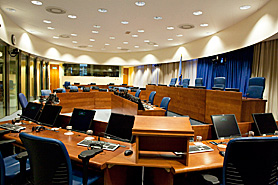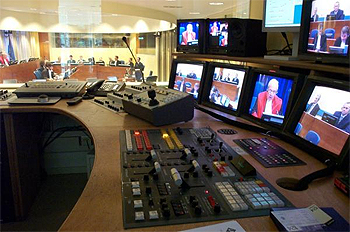All of these requirements necessitated the building of technologically advanced courtrooms at the Tribunal. These technical facilities provide for respect of the rights of the accused, the protection of witnesses and the broadcast of proceedings. When the Tribunal was first established in 1993, most national jurisdictions did not broadcast criminal trials. Nor did they typically have a need to translate their proceedings into two languages, let alone four. When the Tribunal held its first trial in 1996 against Duško Tadić, the Tribunal had a modern courtroom with simultaneous translation into three languages and facilities to permit the international media to broadcast the trial to the world.
 |
The Tribunal now has three courtrooms that broadcast initial appearances, judgements and sentencing hearings live, and all other legal proceedings with a 30-minute delay. All three courtrooms are equipped with several soundproof translation booths. They also have a court reporter who transcribes proceedings while software produces an electronic version of the transcript in real time that can be accessed by courtroom participants through computer screens at their desks.
The Tribunal provides the media facilities to obtain audio-visual feeds of the trials that are broadcast quality. Any media outlet with the appropriate equipment can plug into the feeds on ‘first come, first served’ basis. The Tribunal also broadcasts trials in all three courtrooms on the internet. Through the Tribunal website's homepage, you can access audio-visual streaming of the Tribunal’s proceedings in English, Bosnian/Croatian/Serbian (BCS) and where appropriate Albanian, and the audio track in French.
Thanks to its state-of-the-art courtroom technology, the Tribunal is able to bring its proceedings in The Hague to the people of the former Yugoslavia and to the world.
There are six cameras in each courtroom, which are controlled by an audio-visual director located in a soundproof room to the side of the courtroom. The audio-visual directors and technicians are Registry staff and are neutral to the proceedings.
The audio-visual Directors can zoom or pan the cameras. They also collate images from the six cameras into one picture that is broadcast to the outside world. In both filming and editing, the directors must uphold the dignity and decorum of the courtroom. For example, they do not focus unduly on distressed witnesses, accused or other participants.
 |
The Audio-visual directors also have an important role in applying witness protection measures and protecting the confidentiality of certain proceedings. On the order of the Tribunal’s judges, audio-visual directors will ensure the pixilated image of the face, or distorted voice, or both, for protected witnesses is perfect in case confidential information is accidentally divulged in the courtroom.
On the judges’ orders, the Audio-Visual Technician removes the footage in question from the public feed, which is broadcast to the outside world with a 30-minute delay.
The court room support unit has dedicated Technicians who are responsible for the court room technical services each day prior and during the court room proceedings which also includes the distribution of court room signals to the international press and for the internet streaming service.
All court participants, be they judges, prosecutors, defence counsel or witnesses have access to a computer screen on their desk which allows them to alternate between four different viewing options. On one channel they see the electronic version of the transcript that the court reporter is transcribing of the day’s proceedings in real time. There are also two channels which allow court participants to view exhibits, such as photographs and documents that are presented in hard copy in court, and computer evidence. Finally, the video channel allows court participants to see what the courtroom director is filming.

